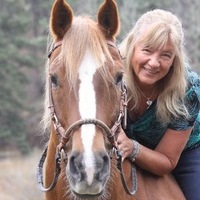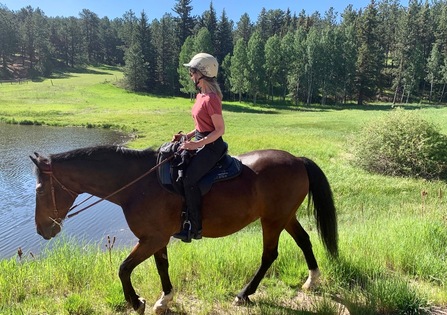
The Most Popular Horse Breeds Of 2019
Equestrian Advice & Guides General Equestrian
Build your business profile for FREE and expose your services to thousands of potential clients!
Create my profile now!
Have you ever ridden a horse that you swear could read your mind? He does what you want before you even ask and seems to know your very thoughts. Likely he does intuit what you’re are going to command, but not because he’s a mind reader, as such, but because he’s aware and present with you every single second you are with him. This means he is constantly listening to your body, your breathing, your heartbeat and probably a hundred other invisible things that you aren’t aware you do on a regular basis. He reacts to these precursors to any cue so quickly that most folks may not even know it’s happening!
Pretty cool, but how do you learn to intensify this amazing ability of his so that you become the most proficient rider you can be? Let’s look at the basics first: Stop and go.
As an instructor for over 45 years, I’m always amazed by the answers I get to this one simple question when I ask it of new students. How do you make your horse go forward? (And conversely, how to stop him?) Oh, and it doesn’t matter if I’ve asked beginners or advanced riders; I’ve only ever gotten the correct answer one time, and ironically, it was from a rank beginner who’d never ridden.
Going forward is simple and most people answer using a variation of the proverbial: “Kick, squeeze, or kiss to him to move. To stop, just pull back, or sit deep.“
Done. Right? Um, no, so what is the answer? Take your time. Think about it for a minute. For this example, you could be mounted or you can be working on the ground, it doesn’t really matter as the answer is the same.
Most people tell me they give the cue to walk, which is a nudge, a kick, a release of the reins, but although all could work, they are not correct.
Let’s get the rider off of the horse and standing on their own two feet instead. How do you go from standing still to walking ahead? Again, take your time. Think about it and when you have your answer, read on.
I’ll outline it here and though not all will be surprised, I bet some will cluck to themselves that yes, of course, you’d do these things. It’s the awareness of knowing what we do that makes us better able to communicate with the horse clearly. Your horse feels everything you do while on him and sees every move you make when you are not. So asking him to walk forward is not as simple as pounding on him to go or throwing the reins at his mouth so he can go. No, there is a very specific and non-negotiable process that happens each and every time we move—with or without a horse.
Here are the steps to move forward, in order.
THINK. Think about your destination. Think about what you want to do and where you want to go. We’ll use walking to the fence as our end goal.
ENVISION. Imagine where you want to go. The fence may be around a corner where we can’t see it, or it may be directly in front of you. Either way, you’ll envision where it is in order to map your way to reaching it.
LOOK. If you can see it, look at the fence so you know exactly where it is. Is it to your left? Straight ahead, or around the barn? In any event, you’ll look in the direction you want to take.
BRING YOUR ENERGY UP. This one is the stumper for sure. I mean, who thinks of this step anyway? But without it, you don’t move. We all do this so naturally, it has no conscious thought associated with it; we just bring our energy up and then move.
LEAN FORWARD. You’ll do this on the ground and while you are on your horse, but again, do you even realize it? Standing, you are in Neutral, you must now shift gears and begin the moving process that will propel you forward.
MOVE A LEG. On a horse, you may move both legs, depending where you are going. On our own, we lean forward and throw ourselves off balance, then catch ourselves with a foot.
Okay, so that’s GO. Now, let’s Stop. Your steps are pretty much the same, only backwards, or more accurately, mixed up. Basically, you’ll do the following:
THINK about stopping.
ENVISION the perfect square and obedient halt.
LOOK at the spot you want to stop and don’t stare at it, but know
where your stop marker is located so you don’t drift past or coast through it. (I encourage pretending there is a cliff you’ll go over if you don’t.)
DROP YOUR ENERGY. This one gets misconstrued and “Sitting back” or “Sitting deep or down,” or “Stick your feet out in front of you and throw your weight back,” but none of these are accurate or correct. Dropping your energy is simply the lowering of your intent; not your whole body. Don’t slump, slouch, through away your posture, but sit so you stop moving your pelvis and hips. A true halt perfected looks almost as if the person is bringing their energy up because they may raise their rib cage or push their shoulders slightly back, but they are lowering their energy and the command to “Go.”
LEAN BACK. Only not really. This one is complex. So, let’s say there are 3 body positions for you (because, basically, there are) where Neutral is you sitting on your seat bones with a vertical line through your head, shoulders, hips and back of calf. Forward is your body from the hip up, moving slightly in front of Neutral. Just enough that if you are standing squarely on your own feet, you’ll tip just enough that you feel yourself roll onto the balls of each foot. The third position is back, where your vertical upper body is now a centimeter behind Neutral and you are now rocked back on your heels if you are standing.
STOP MOVING YOUR LOWER BACK which in turn means stop moving your legs. The waistband of your breeches or jeans is the area I’m talking about. Stop moving that and your hips don’t move and your legs don’t move and Boom! You have stopped. This works whether you are on a horse or not on a horse.
So there’s “Stop And Go” in a nutshell. Six steps up and six back down. Learn to become aware of each and know this: Your horse already knows your six steps. I suspect he knows if you use more than these six.
Happy and safe trails!
~Tanya
Get your FREE, yes, FREE Trail Riding, Happily Ever After eBook here:
https://lp.constantcontact.com/su/Qa0qA96/HorseClicks
Hard copy available on my website. TanyaBuck.com

